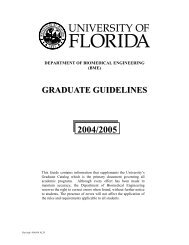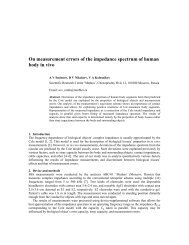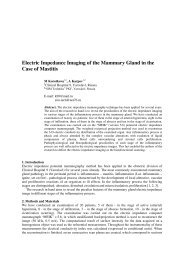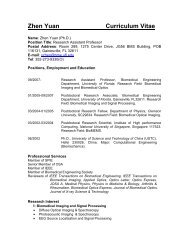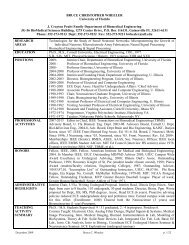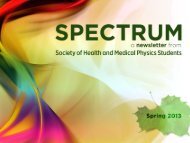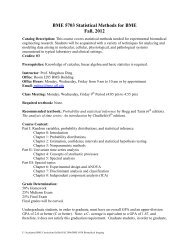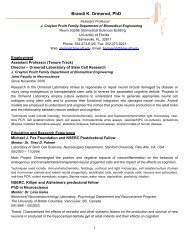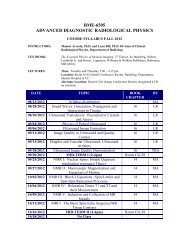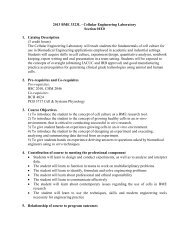Low frequency impedance spectroscopy of cell monolayers using ...
Low frequency impedance spectroscopy of cell monolayers using ...
Low frequency impedance spectroscopy of cell monolayers using ...
Create successful ePaper yourself
Turn your PDF publications into a flip-book with our unique Google optimized e-Paper software.
<strong>Low</strong> <strong>frequency</strong> <strong>impedance</strong> <strong>spectroscopy</strong> <strong>of</strong> <strong>cell</strong> <strong>monolayers</strong><strong>using</strong> the four-electrode methodH Asfour 1 , W Soller 1 , NG Posnack 2 , AE Pollard 3 and MW Kay 1,21Department <strong>of</strong> Electrical and Computer Engineering2Department <strong>of</strong> Pharmacology and PhysiologyThe George Washington University, Washington, DC, USA.3 Department <strong>of</strong> Biomedical EngineeringThe University <strong>of</strong> Alabama in Birmingham, Alabama, USA.E-mail: asfour@gwmail.gwu.eduAbstract. We have developed an <strong>impedance</strong> <strong>spectroscopy</strong> system for monitoring changes inextra<strong>cell</strong>ular conductivity and <strong>cell</strong>-to-<strong>cell</strong> coupling in <strong>cell</strong>s cultured on microelectrode arrays(MEAs). Impedance spectra were measured at low frequencies (0.5-10kHz) <strong>using</strong> the fourelectrodetechnique and standard electrophysiological instruments. A reduction in extra<strong>cell</strong>ularconductivity (<strong>using</strong> isotonic sucrose solution) was observed as an elevation <strong>of</strong> <strong>impedance</strong> at allmeasured frequencies. A reduction in <strong>cell</strong> coupling (<strong>using</strong> heptanol) was observed as anelevation <strong>of</strong> <strong>impedance</strong> at low frequencies (
Adequately small spacing between stimulating electrodes is required for this to work <strong>using</strong> <strong>frequency</strong>modulation [4-6]. At low frequencies, relatively little current penetrates the <strong>cell</strong>; it is shunted throughthe extra<strong>cell</strong>ular space. At high frequencies, the capacitive <strong>impedance</strong> <strong>of</strong> the membrane is low, so asignificant amount <strong>of</strong> current flows through the <strong>cell</strong>. Accordingly, <strong>frequency</strong> dependent <strong>impedance</strong>changes may indicate relative differences between intra- and extra<strong>cell</strong>ular conductivities. Our goal hasbeen to use this concept for assessment <strong>of</strong> extra<strong>cell</strong>ular conductivity and <strong>cell</strong>-to-<strong>cell</strong> coupling in <strong>cell</strong>culture <strong>monolayers</strong>.Our objectives were to 1) show the effect <strong>of</strong> stimulation electrode spacing on four-electrode<strong>impedance</strong> measurements <strong>of</strong> fibroblast <strong>cell</strong> <strong>monolayers</strong> and 2) measure changes in four-electrode<strong>impedance</strong> spectra caused by alterations <strong>of</strong> extra<strong>cell</strong>ular conductivity and <strong>cell</strong>-to-<strong>cell</strong> coupling. Toaccomplish these objectives, <strong>cell</strong> <strong>monolayers</strong> were grown on commercially available MEAs.Impedance spectra were measured at low frequencies <strong>using</strong> standard electrophysiological instruments.2. Materials and MethodsMEAs (Multichannel Systems, Reutlingen, Germany) having either gold (100µm dia) or titaniumnitride (10µm dia) contact electrodes with inter-electrode spacings <strong>of</strong> either 700µm or 30µm (figure1A) were mounted within an adapter (Multichannel Systems, MEAadapt) that provided pin-outs foreach electrode. Current (I stim ) was injected between stimulating electrodes (the two outermost pairs,A i :D i and A iv :D iv , figure 1B) <strong>using</strong> an AC/DC current source (Keithley 6220) at frequencies between0.5Hz and 10kHz (3 points per decade). Extra<strong>cell</strong>ular potentials (ΔΦ) were measured from the twocenter electrodes (B:C, figure 1B) <strong>using</strong> a differential amplifier (Dagan EX4-400). Signals wererecorded <strong>using</strong> a laptop PC, DAQ hardware (NI DAQCard-6062E), and custom LabVIEW s<strong>of</strong>tware.Sampling frequencies ranged from 1000sps to 90Ksps and were set at least 10 times higher than the<strong>frequency</strong> <strong>of</strong> current injection. The amplitude <strong>of</strong> extra<strong>cell</strong>ular potentials (|ΔΦ|) was measured <strong>using</strong>custom Matlab routines by fitting potentials at each <strong>frequency</strong> to a sine wave at the <strong>frequency</strong> <strong>of</strong> thestimulating current. Impedance magnitude at each <strong>frequency</strong> was then calculated as |Z|=|ΔΦ| / |I stim |.First, <strong>impedance</strong> was measured for clean MEAs containing 750 μL <strong>of</strong> either 10% FBS or Tyrode’ssolution. Current limits were set to prevent solution ionization, usually a max <strong>of</strong> 100nA. MEAs werethen plated with fibroblasts (PT67). Cell concentrations varied between 0.5 and 2 million <strong>cell</strong>s per mL.Cultures were incubated overnight and measurements were acquired the next day at room temperatureafter replacing the FBS solution with a buffered Tyrode’s solution.Cell-to-<strong>cell</strong> coupling and extra<strong>cell</strong>ular conductivities were then sequentially altered. Heptanol (agap junction uncoupler) was applied (1mM) and <strong>impedance</strong> spectra were measured after 10 minutes.Cultures were carefully rinsed three times to remove heptanol and 750 μL <strong>of</strong> isotonic sucrose solutionwas added to the culture. Impedance spectra were measured after 10 minutes. Trypsin was then addedto cultures, <strong>cell</strong>s were washed from the MEA, and 750 μL <strong>of</strong> Tyrode’s solution was added to theATypical MEA LayoutBMEA SizesElectrodeInter-electrodeDiameterspacing100µm 700µm10µm 30µmCKeithley CurrentsourceΔΦI stimR senseDAQComputerFigure 1. Four electrodes <strong>impedance</strong> measurementsystem. A: Typical MEA geometry. B: Implementation<strong>of</strong> the four electrodes technique <strong>using</strong> MEAs. C:Equipment for injecting current and measuring ΔΦ.Figure 2. Fibroblasts cultured on top <strong>of</strong> goldelectrodes (100μm dia). A: Closeup <strong>of</strong> theconfluent monolayer. B: One electrodeshowing the insulated region (area1) and theexposed region (area2). C: Image showingmonolayer confluency over the electrode.
MEA. Impedance measurements were repeated. MEAs were then treated with an enzymatic pH neutraldetergent (Tergazyme, Alconox Inc.) and <strong>impedance</strong> measurements were repeated.3. Results and DiscussionImpedance at 0.5Hz for clean MEAs (100μm electrode dia) having 750 μL <strong>of</strong> dionized water,isotonic sucrose solution, or FBS solution was approximately 2000Ω, 1000Ω, 200Ω, respectively.Confluent <strong>monolayers</strong> were obtained a day after <strong>cell</strong> plating (figure 2). To ensure confluency andelectrode coverage, <strong>monolayers</strong> were inspected <strong>using</strong> a confocal microscope (Zeiss LSM510) afterstaining the <strong>cell</strong>s with CellTracker TM (Invitrogen) (figure 2).Impedance was dependent upon the spacing between stimulating electrodes (figures 3&4).Typically, <strong>impedance</strong> measured at larger stimulation electrode spacing was lower than <strong>impedance</strong>measured at smaller stimulation electrode spacing. This effect might be described by simple volumeconductor theory if the supplied current always remained outside <strong>of</strong> the <strong>cell</strong>s. However, the validity <strong>of</strong>our approach relies upon the redistribution <strong>of</strong> current, in part, to the intra<strong>cell</strong>ular volume. In thissituation a description that accounts for the separate contributions <strong>of</strong> the intra<strong>cell</strong>ular and extra<strong>cell</strong>ulardomains becomes necessary. Presently, there is no analytic description <strong>of</strong> this redistribution, unless anFigure 3. Impedance spectra before and after applying trypsin and after cleaning the MEA(100 µm electrode dia). A: Spectra <strong>using</strong> a stimulation electrode spacing <strong>of</strong> 4.9mm. B: Spectra<strong>using</strong> a stimulation electrode spacing <strong>of</strong> 2.1mm.Figure 4. Alterations <strong>of</strong> extra<strong>cell</strong>ular conductivity and <strong>cell</strong>-to-<strong>cell</strong>coupling. Average <strong>impedance</strong> change (left) and typical <strong>impedance</strong>spectra (right) are shown. Error bars represent MSE. A: Replacement<strong>of</strong> <strong>cell</strong> culture media with isotonic sucrose solution. B: Application<strong>of</strong> heptanol (1mM).Figure 5. Top: Confluentmonolayer on a High-DenseMEA (10 µm dia electrodes).Bottom: Impedance spectra (90µm stim electrode spacing).
assumption <strong>of</strong> uniform, isotropic conductivities is valid. However, there are compelling reasons tobelieve that this assumption does not apply to our experimental conditions. A goal <strong>of</strong> future studies isto develop an analytic framework for describing the redistribution <strong>of</strong> current in our <strong>cell</strong> <strong>monolayers</strong>.Impedance was drastically reduced after the application <strong>of</strong> trypsin (figure 3), indicating that <strong>cell</strong>swere adhered to MEA electrodes and that adhesion was disrupted after applying trypsin. The effect <strong>of</strong>trypsin was most apparent at frequencies below 1kHz. Impedance was further reduced after cleaningthe electrodes with an enzymatic detergent, indicating the presence <strong>of</strong> residual proteins after thedetachment <strong>of</strong> <strong>cell</strong>s (figure 3). Impedance spectra measured from non-confluent <strong>monolayers</strong> showedlittle difference before and after the application <strong>of</strong> trypsin, indicating that measurements are dependentupon adequate coverage <strong>of</strong> the electrodes with <strong>cell</strong>s.Reducing extra<strong>cell</strong>ular conductivity with isotonic sucrose solution increased <strong>impedance</strong> at allfrequencies below 10kHz (figure 4A). Specific changes were 125%±44% at 0.5Hz, 75%± 17% at 5Hz,and 300%±19% at 5kHz. The magnitude <strong>of</strong> <strong>impedance</strong> changes after reducing gap junctionconductance were less and appeared to be <strong>frequency</strong> dependent (figure 4B). Impedance increased atlower frequencies (27%± 13% at 0.5Hz and 16%±12% at 5Hz) while <strong>impedance</strong> decreased at higherfrequencies (-8.4%±20% at 5kHz), but was not significant.Cells were also plated on MEAs having titanium nitride electrodes (10µm dia, High-Dense MEAs).We found that although the effect <strong>of</strong> electrode <strong>impedance</strong> is less <strong>using</strong> the four-electrode technique,<strong>impedance</strong> measured <strong>using</strong> the 10µm dia electrodes was at least an order <strong>of</strong> magnitude higher than<strong>impedance</strong> measured <strong>using</strong> 100µm dia electrodes (figure5). In addition, <strong>impedance</strong> differencesmeasured before and after applying trypsin to <strong>cell</strong>s were usually smaller for the 10µm dia electrodes.Impedance measurements required low levels <strong>of</strong> stimulation currents and measurements <strong>of</strong> smallpotential differences, therefore minimization <strong>of</strong> noise was important. This was done by shielding theequipment and placing the MEA adapter within a Faraday cage. Sine wave fitting to measuredpotential differences minimized the effect residual noise levels. Raw signal to noise ratios (SNRs)were lowest at low frequencies. SNR at 1Hz was 60dB while SNR at 5kHz was 5dB.Since changes in phase due to monolayer perturbations might be more sensitive than changes in the<strong>impedance</strong> magnitude [7], future work will involve the development <strong>of</strong> techniques for measuring<strong>impedance</strong> magnitude and phase and for conducting studies within an incubator.4. Summary and ConclusionsWe have shown how MEAs and the four-electrode method can be used for non-invasivemeasurements <strong>of</strong> <strong>cell</strong> monolayer conductivities, with emphasis at low frequencies (0.5Hz to 10kHz).Impedance was dependent upon the spacing between stimulating electrodes. Impedance reduced withincreasing spacing. Reducing extra<strong>cell</strong>ular conductivity (replacing FBS with isotonic sucrose solution)was observed as an elevation <strong>of</strong> <strong>impedance</strong> at all measured frequencies. Reduced <strong>cell</strong> coupling (<strong>using</strong>heptanol) was observed as an elevation <strong>of</strong> <strong>impedance</strong> at low frequencies (



